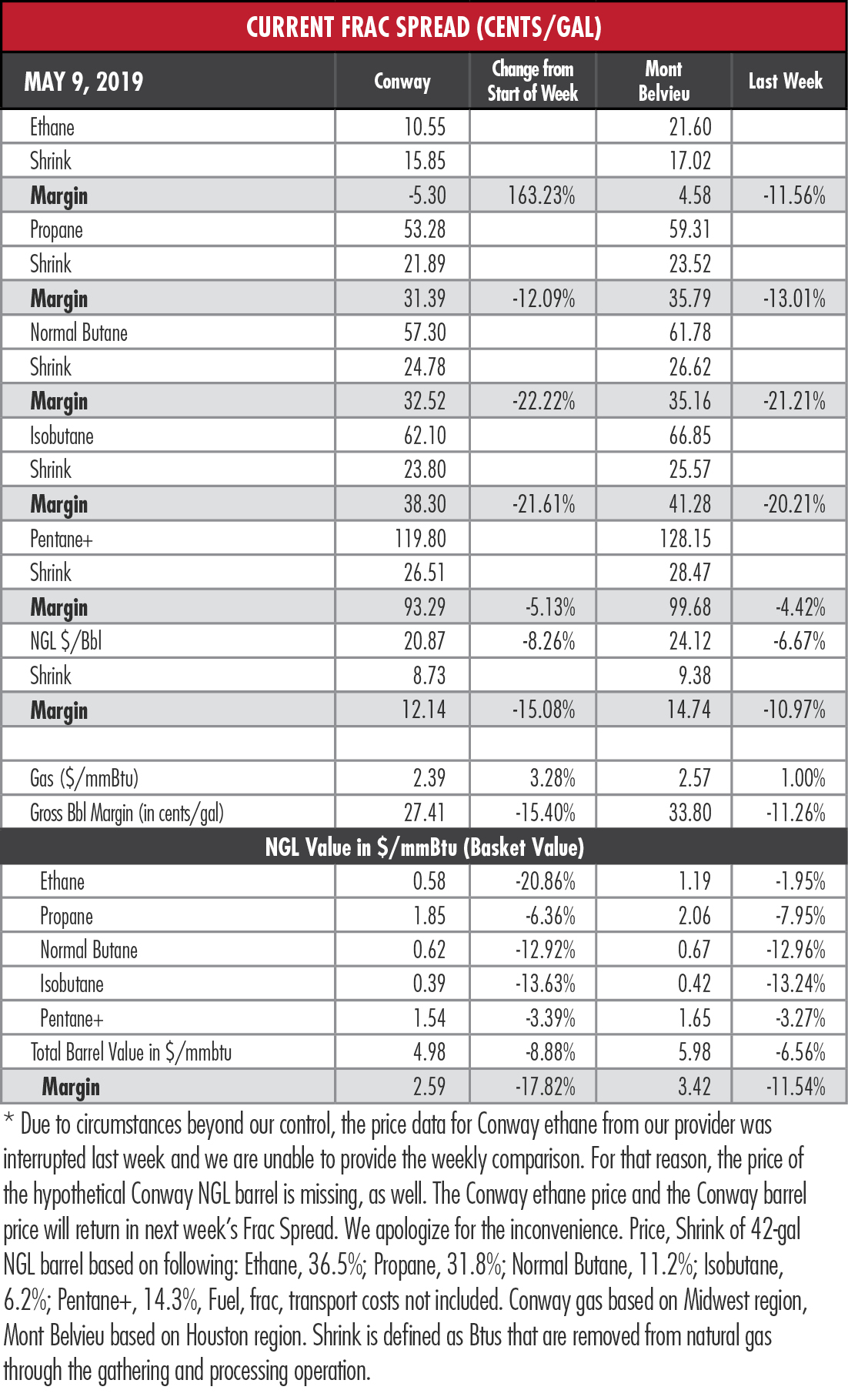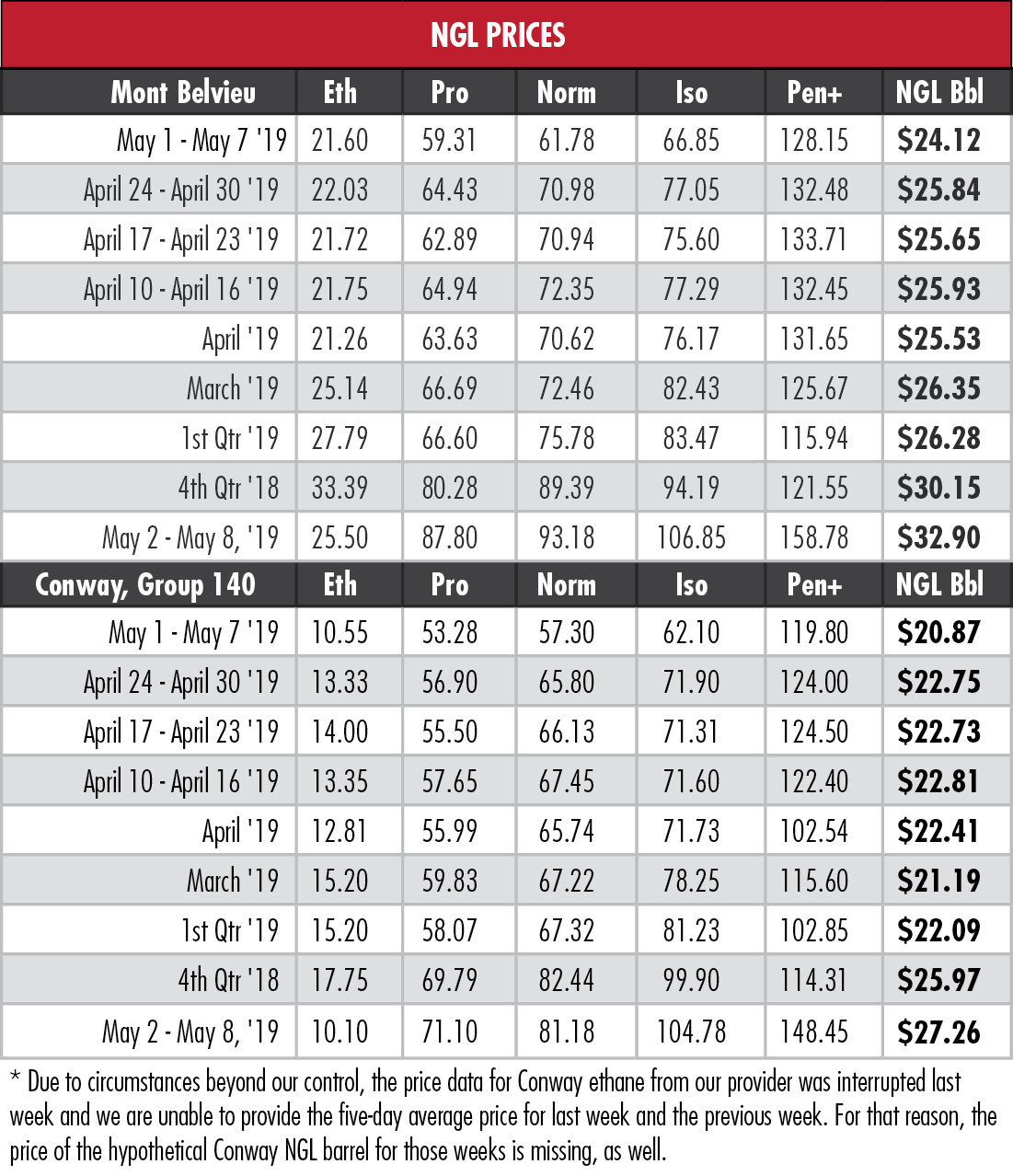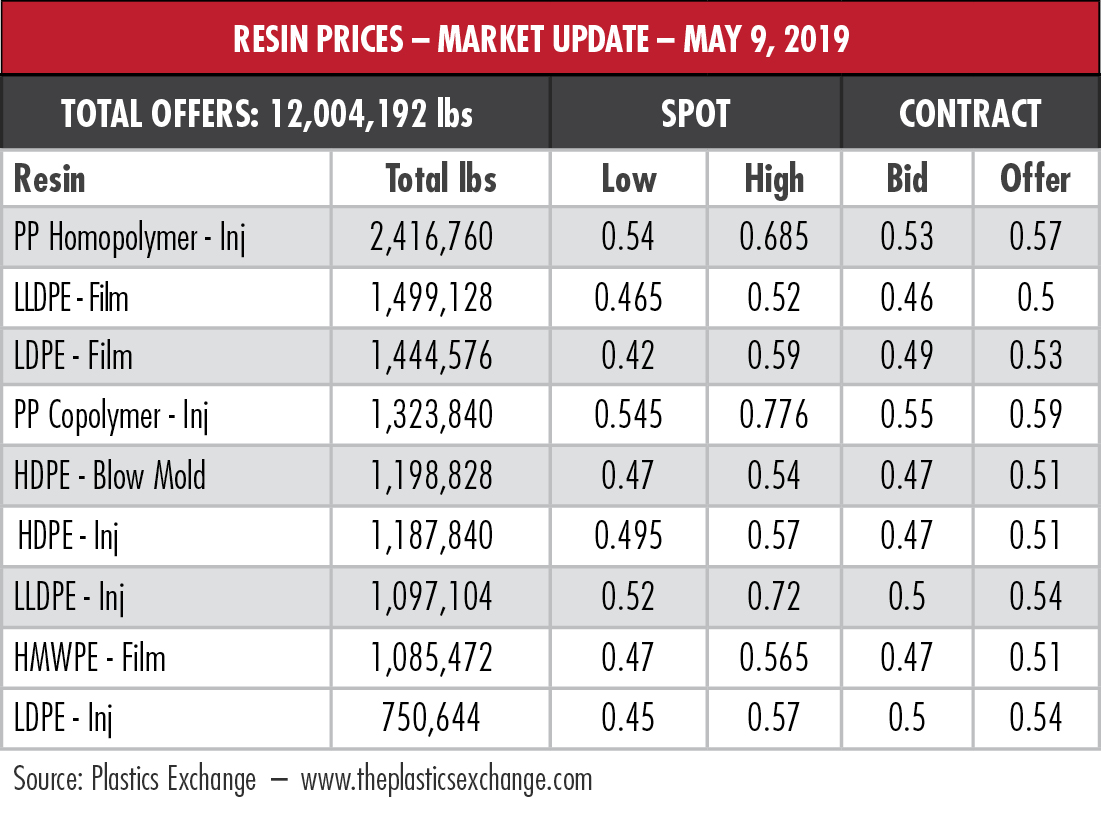
(Source: Shutterstock, HartEnergy.com)
The price of Mont Belvieu, Texas, butane responded to high inventories by weakening to a 32-month low last week as fall-offs across the board pulled the hypothetical NGL barrel down 6.7% to its low for the year.
By contrast, a report by the U.S. Energy Information Administration (EIA) showed that U.S. crude oil inventories fell by 4 million barrels (MMbbl) in the week ending May 3, defying analysts’ prediction of a 1.2 MMbbl increase. The news pushed oil up by 72 cents to $62.12 a barrel on May 8, a 1.2% gain.
But the Trump administration on May 8 added sanctions against Iranian metals exports and alerted European allies to cease doing business with Tehran. Oil-rich Venezuela’s standoff between its sitting president and its U.S.-backed opposition does not appear close to a resolution. And escalating trade tensions between the U.S. and China, with the administration threatening to raise tariffs on May 10 from 10% to 25% on $200 billion worth of Chinese imports, are not helping.
 Until May 9, the conflict between the world’s largest economies had botheried stock markets much, the New York Times reported, because traders believed that President Donald Trump would back off his threats if he believed the markets and economy look soft. The president, wrote Neil Irwin, has made it clear that he values stock market performance.
Until May 9, the conflict between the world’s largest economies had botheried stock markets much, the New York Times reported, because traders believed that President Donald Trump would back off his threats if he believed the markets and economy look soft. The president, wrote Neil Irwin, has made it clear that he values stock market performance.
The U.S. economy, however, has shown itself to be strong this year and on the evening of May 8, Trump declared that “They broke the deal” and hinted he was prepared to raise tariffs on Chinese goods. At mid-morning on May 9, the Dow Jones industrial average was down 1.45% and the S&P 500 had lost 1.26%.
And if negotiators from China and the U.S. can’t find a way out of a conflict? There is a danger, Irwin said, that the economy could experience “a meaningful downturn and potentially a recession.” In that scenario, economists at Moody’s Analytics project, the GDP growth would contract by 1.8 percentage points and unemployment would rise.
 That might appear to be an oddly gloomy outlook, given how the U.S. economy has continued to grow month after month. But in the energy space, traders are keeping watch over the global economy as a whole and not just the performance of the Dow. And there are reasons to believe that it’s not doing that great.
That might appear to be an oddly gloomy outlook, given how the U.S. economy has continued to grow month after month. But in the energy space, traders are keeping watch over the global economy as a whole and not just the performance of the Dow. And there are reasons to believe that it’s not doing that great.
“Our new World Economic Outlook (WEO) projects a slowdown in growth in 2019 for 70% of the world economy,” wrote Gina Gopinath, chief economist of the International Monetary Fund, in a blog. “Global growth softened to 3.6% in 2018 and is projected to decline further to 3.3% in 2019.”
Slower growth translates into less demand for oil to fuel economic expansion, which is part of the reason that the recent flurry of geopolitical prompts have resulted in incremental jumps, but not leaps in the price of oil.
 The second half of 2019 is looking stronger and global growth can be expected to return to 3.6% in 2020, Gopinath wrote. But she warned that “this recovery is precarious and predicated on a rebound in emerging market and developing economies, where growth is projected to increase from 4.4% in 2019 to 4.8% in 2020.”
The second half of 2019 is looking stronger and global growth can be expected to return to 3.6% in 2020, Gopinath wrote. But she warned that “this recovery is precarious and predicated on a rebound in emerging market and developing economies, where growth is projected to increase from 4.4% in 2019 to 4.8% in 2020.”
In other words, a booming U.S. economy won’t get it done for the oil and gas industry, which needs rapidly growing economies for it to grow. In the U.S., technological advances that have improved industrial efficiency, not to mention the growth in market share of electric and hybrid vehicles, has dampened demand for oil.
In the week ended May 3, storage of natural gas in the Lower 48 experienced an increase of 85 billion cubic feet (Bcf), the EIA reported, compared to the Stratas Advisors prediction of an 87 Bcf increase and the Bloomberg consensus of an 88 Bcf increase. The figure resulted in a total of 1.547 trillion cubic feet (Tcf). That is 9% above the 1.419 Tcf figure at the same time in 2018 and 16.4% below the five-year average of 1.85 Tcf.
Recommended Reading
E&P Earnings Season Proves Up Stronger Efficiencies, Profits
2024-04-04 - The 2024 outlook for E&Ps largely surprises to the upside with conservative budgets and steady volumes.
CEO: Coterra ‘Deeply Curious’ on M&A Amid E&P Consolidation Wave
2024-02-26 - Coterra Energy has yet to get in on the large-scale M&A wave sweeping across the Lower 48—but CEO Tom Jorden said Coterra is keeping an eye on acquisition opportunities.
Endeavor Integration Brings Capital Efficiency, Durability to Diamondback
2024-02-22 - The combined Diamondback-Endeavor deal is expected to realize $3 billion in synergies and have 12 years of sub-$40/bbl breakeven inventory.
Exxon, Chevron Tapping Permian for Output Growth in ‘24
2024-02-02 - Exxon Mobil and Chevron plan to tap West Texas and New Mexico for oil and gas production growth in 2024, the U.S. majors reported in their latest earnings.
Patterson-UTI Braces for Activity ‘Pause’ After E&P Consolidations
2024-02-19 - Patterson-UTI saw net income rebound from 2022 and CEO Andy Hendricks says the company is well positioned following a wave of E&P consolidations that may slow activity.






